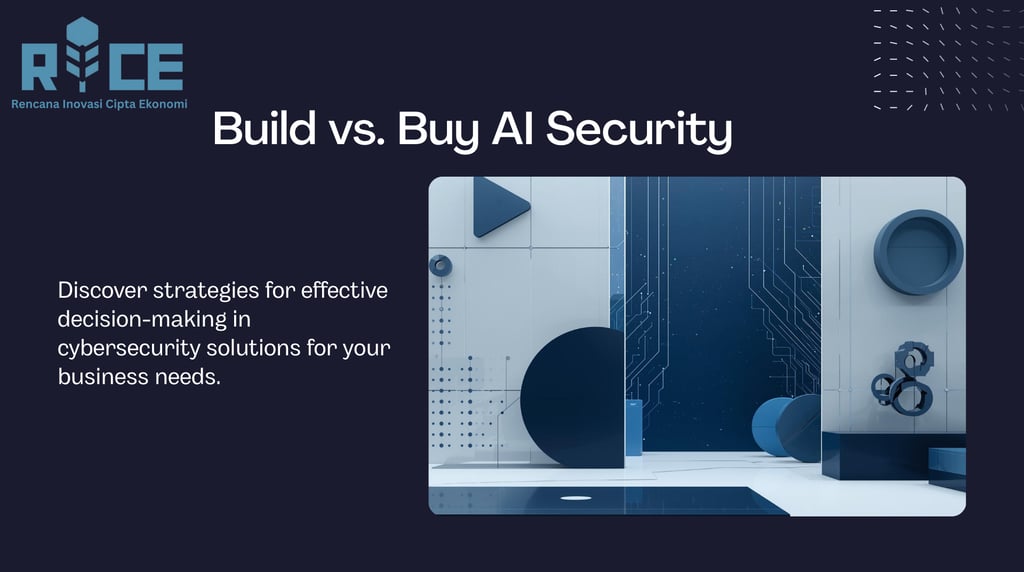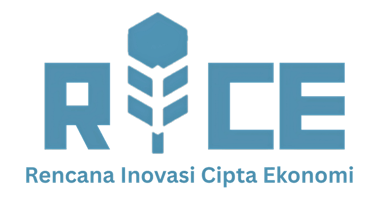Build vs. Buy AI Security: An Expert's Guide to Choosing Your Cyber Arsenal
Navigate the 'build vs. buy' choice for AI security. This guide helps organizations select the optimal cyber defense strategy for their AI assets.
TECHNOLOGY
Rice AI (Ratna)
11/24/20258 min read


As artificial intelligence rapidly reshapes industries, it also introduces unprecedented cybersecurity challenges. Organizations deploying AI systems face a critical strategic decision: should they develop their AI security solutions internally, known as the "build" approach, or integrate third-party offerings, the "buy" strategy? This choice is not merely technical; it profoundly impacts an organization’s operational efficiency, financial outlay, and overall risk posture in an era of escalating cyber threats.
The complexity of AI threats, from data poisoning to adversarial attacks, demands specialized and robust defenses that often outpace traditional security paradigms. Understanding the nuances of building bespoke solutions versus buying market-tested products is paramount for safeguarding your AI investments and maintaining cyber resilience. This expert guide will dissect the advantages and disadvantages of each approach, providing a framework for informed decision-making in your quest to fortify your digital infrastructure against the evolving landscape of AI-driven cyber threats.
The Evolving Threat Landscape in AI
The integration of artificial intelligence across business operations ushers in a new frontier for cybersecurity. While AI offers immense potential for innovation and efficiency, it simultaneously creates novel vulnerabilities that malicious actors are quick to exploit. Traditional security measures, designed for rule-based systems, often prove inadequate against the dynamic and opaque nature of AI models.
Unique Vulnerabilities of AI Systems
AI systems, by their very design, present unique attack surfaces. Data poisoning attacks, for instance, manipulate training data to corrupt a model's future behavior, leading to erroneous or malicious outcomes. Adversarial attacks introduce subtle perturbations to input data, causing AI models to misclassify information with high confidence, often imperceptible to human observation. Furthermore, model inversion attacks can reconstruct sensitive training data from a deployed model, raising significant privacy concerns. These sophisticated threats underscore the necessity for specialized AI security strategies that go beyond conventional perimeter defenses.
The Imperative for Robust AI Cyber Defenses
The potential business impacts of an AI-specific breach are severe, ranging from financial losses due to disrupted operations or intellectual property theft, to reputational damage and regulatory penalties. A compromised AI system could lead to biased decision-making, operational downtime, or even autonomous malicious actions. Consequently, investing in robust AI cyber defenses is no longer optional but a strategic imperative. Proactive security measures, tailored to the unique risks of AI, are essential for ensuring the integrity, confidentiality, and availability of AI-driven assets. Organizations must prioritize understanding and mitigating these risks to maintain trust and operational continuity.
Building Your Own AI Security Solutions
Opting to build AI security solutions in-house is a path chosen by organizations seeking unparalleled control and customization. This approach involves dedicating internal resources to research, develop, and deploy security measures specifically designed for an organization's unique AI models, data pipelines, and operational environment. It demands significant investment but promises a security posture meticulously aligned with enterprise-specific needs.
Advantages of Building In-House
The primary advantage of building AI security solutions internally is the promise of full customization. An in-house team can develop security protocols and tools that perfectly integrate with an organization's existing technology stack, bespoke AI models, and specific operational workflows. This level of tailored integration ensures that security gaps inherent to unique architectural designs are addressed with precision. Furthermore, building in-house grants greater control over intellectual property and data governance. Organizations retain full ownership of their security innovations, potentially leading to a competitive advantage by creating proprietary defenses that are harder for adversaries to circumvent. This also fosters deep expertise development within the organization, cultivating a specialized team proficient in both AI and cybersecurity, reducing reliance on external vendors for critical security functions.
Challenges and Considerations for Building
Despite the allure of customization, the "build" approach presents significant challenges. It requires a substantial upfront investment in R&D, infrastructure, and, critically, talent acquisition. Finding experienced AI security engineers, data scientists with a security focus, and machine learning experts capable of developing and maintaining advanced security systems is difficult and costly. This specialized hiring often leads to a longer time-to-market for effective solutions, as development cycles can be extensive.
Moreover, the high maintenance costs extend beyond initial development to continuous innovation. The AI threat landscape evolves rapidly, demanding constant updates, research, and adaptation of in-house solutions to remain effective. Without dedicated and persistent resource allocation, there's a significant risk of falling behind sophisticated and quickly adapting threat actors. This continuous investment can strain budgets and divert resources from core business activities. At Rice AI, we understand these complexities, which is why we assist organizations in building tailored AI security frameworks. Our specialized consulting and development support helps bridge the expertise gap, ensuring your in-house efforts are both strategic and sustainable, mitigating the risks associated with sole reliance on internal capabilities.
Buying Off-the-Shelf AI Security Solutions
For many organizations, the "buy" approach, involving the procurement of third-party AI security solutions, offers a compelling alternative to internal development. This strategy leverages the expertise and resources of specialized vendors, providing a faster route to implementing robust defenses without the extensive overhead of building from scratch.
Advantages of Buying External Solutions
One of the most attractive aspects of buying AI security solutions is faster deployment and immediate access to advanced capabilities. Commercial products often come pre-built and tested, allowing organizations to implement defenses quickly, significantly reducing their time-to-market for essential security measures. This approach also typically entails lower upfront capital expenditure compared to building, with costs often structured as predictable subscriptions, making budgeting simpler. External vendors specialize in AI security, dedicating significant resources to threat intelligence, R&D, and staying ahead of the latest attack vectors. This means organizations gain access to cutting-edge technologies and expertise that might be prohibitive to develop in-house. Furthermore, buying solutions can lead to a reduced operational burden on internal teams, freeing them to focus on core AI development and business innovation. Purchased solutions often offer greater scalability and are designed for easier integration with diverse existing systems, streamlining the process of securing complex AI environments.
Challenges and Considerations for Buying
While buying offers speed and specialized expertise, it introduces its own set of challenges. Organizations face the potential for vendor lock-in, becoming dependent on a specific provider for critical security functions, which can limit future flexibility or increase costs if switching vendors becomes necessary. Customization limitations are also a factor; off-the-shelf solutions may not perfectly fit highly niche or proprietary AI systems, potentially leaving specific vulnerabilities unaddressed. Integrating these solutions with a diverse and often complex existing IT infrastructure can present integration complexities, requiring significant effort and expertise.
Thorough due diligence is paramount for vendor selection. Organizations must meticulously vet providers, assessing their security posture, track record, and commitment to ongoing innovation to ensure trust. Finally, data privacy concerns arise when third parties handle sensitive information. Organizations must ensure that vendor solutions comply with all relevant data protection regulations and internal policies, as outsourcing security does not absolve them of responsibility for data breaches.
Critical Factors in Your Decision-Making Process
The choice between building and buying AI security solutions is not one-size-fits-all. It requires a comprehensive assessment of internal capabilities, external threats, and strategic objectives. A structured decision-making process, evaluating several key determinants, is essential for selecting the most appropriate path for your organization.
Risk Appetite and Compliance Requirements
An organization's risk appetite is a fundamental factor. Companies operating in highly regulated industries, such as finance, healthcare, or critical infrastructure, often have a lower tolerance for risk and stringent compliance requirements. These sectors may find a customized "build" approach appealing for granular control over security measures and audit trails, ensuring every regulatory nuance is met. Alternatively, they might opt for commercial "buy" solutions from vendors with strong industry certifications and proven compliance records, requiring meticulous vetting to ensure adherence to standards like GDPR, HIPAA, or NIST. The chosen strategy must demonstrably satisfy all legal and ethical obligations to avoid significant penalties and reputational damage.
Internal Expertise and Resources
A realistic assessment of your organization's internal expertise and resources is crucial. Do you possess a dedicated team with advanced knowledge in both AI and cybersecurity? Can you allocate a substantial budget for staffing, training, and cutting-edge infrastructure necessary for developing and maintaining sophisticated AI security? Organizations with mature R&D departments and specialized talent pools might lean towards building, leveraging their existing capabilities. Conversely, those with limited internal cybersecurity or AI-specific talent may find the "buy" option more viable, as it provides immediate access to specialized skills and technology without the burden of extensive hiring and training. This evaluation extends beyond initial setup to the long-term commitment required for continuous updates and threat intelligence.
Time-to-Market and Speed of Threat Evolution
The time-to-market for a security solution can be a decisive factor, especially given the speed of AI threat evolution. New adversarial techniques emerge constantly, making rapid deployment of effective defenses critical. Building bespoke solutions typically involves longer development cycles, potentially leaving an organization exposed during the interim. Commercial "buy" options, by contrast, often offer quicker deployment and immediate protection against known and emerging threats, as vendors are constantly updating their products. Organizations operating in environments with particularly aggressive or rapidly changing threat landscapes might prioritize speed and therefore lean towards purchasing pre-built, continuously updated solutions to maintain a responsive defense posture.
Core Business Focus and Strategic Alignment
Finally, the decision must align with your core business focus and strategic objectives. Is AI security considered a core competency that provides a strategic advantage, or is it a vital supporting function? If AI innovation and security are integral to your brand and competitive edge, building a proprietary solution might be a strategic move, fostering unique capabilities. However, if your core business lies elsewhere, and AI security is essential but not a primary differentiator, then purchasing a robust, market-leading solution allows your teams to concentrate on their primary revenue-generating activities. Rice AI offers strategic advisory services specifically designed to help businesses assess these intricate factors. We ensure that your AI security strategy is not just technically sound, but also perfectly aligned with your overarching business goals, bridging the gap between advanced technical requirements and strategic business outcomes.
Strategic Synthesis: Hybrid Approaches and Future Outlook
The choice between "build" and "buy" for AI security is rarely a rigid dichotomy. In today's dynamic threat landscape, a hybrid approach often emerges as the most pragmatic and resilient strategy. This synthesis combines the strengths of both models, allowing organizations to achieve customized protection while leveraging external expertise and speed.
A hybrid strategy might involve buying foundational AI security platforms that handle common threats and compliance requirements, then building specialized modules or integrations on top to address unique risks or proprietary AI applications. For instance, an organization could purchase a robust MLOps security suite for data integrity and model monitoring, then develop in-house adversarial defense mechanisms tailored to its specific high-stakes AI models. This allows for rapid baseline protection while retaining the ability to customize and innovate where it matters most to their competitive advantage or specific risk profile.
The future of AI security will undoubtedly be characterized by increasing sophistication on both sides: more advanced AI threats and more intelligent, self-evolving defense systems. Continuous learning security models, powered by AI themselves, will become indispensable. The need for constant vigilance, adaptive defenses, and collaborative threat intelligence sharing will intensify. Therefore, a well-informed decision now lays the groundwork for long-term cyber resilience.
To summarize, meticulously assess your organization's specific needs, available resources, and risk tolerance. Consider the pace of threat evolution and how quickly your team can respond. Ultimately, the optimal path is one that empowers your organization to effectively safeguard its AI investments, ensuring integrity, trust, and continuity in an increasingly AI-driven world. At Rice AI, we pride ourselves on being a trusted partner in this critical journey. Whether you need expert guidance through the "build vs. buy" conundrum, assistance in implementing robust AI security frameworks, or development of bespoke solutions, we empower businesses to secure their AI systems effectively.
Ready to fortify your AI security strategy and protect your valuable AI assets? Contact Rice AI today for a tailored consultation and let our experts help you craft a resilient cyber arsenal.
#AISecurity #Cybersecurity #BuildVsBuy #AISecurityStrategy #AIThreats #CyberDefense #MachineLearningSecurity #DataSecurity #TechDecisions #InfoSec #CyberRisk #AIInnovation #DigitalTransformation #SecuritySolutions #RiceAI #DailyAITechnology
RICE AI Consultant
To be the most trusted partner in digital transformation and AI innovation, helping organizations grow sustainably and create a better future.
Connect with us
Email: consultant@riceai.net
+62 822-2154-2090 (Marketing)
© 2025. All rights reserved.


+62 851-1748-1134 (Office)
IG: @riceai.consultant
